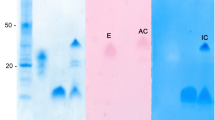Abstract
Proteolytic fragments were obtained by limited proteolysis of 124-kDa (kilodalton) phytochrome from etiolatedAvena sativa using trypsin, endoproteinase-Lys-C, endoproteinase-Glu-C and subtilisin. The fragments were separated by sodium dodecyl sulfate gel electrophoresis, blotted onto activated glass-fiber sheets and investigated by amino-acid sequencing in a gas-phase sequencer. Determination of N-terminal sequences in three to six Edman degradation steps allowed the exact localization of the fragments within the published entire amino-acid sequence of 124-kDaAvena phytochrome (H.P. Hershey, R.F. Barker, K.B. Idler, J.L. Lissemore, P.H. Quail (1985), Nucleic Acids Res.13, 8543–8559). From the knowledge of the exact sites for preferred proteolytic cleavage of undenatured phytochrome, conclusions on the conformation of the phytochrome protein were drawn. Sites of preferred cleavage are considered to be freely exposed to the environment whereas potential cleavage sites which are resistant to proteolysis over a long time are considered to be localized in the interior of the native phytochrome. Two different sites which are exposed in the far-red-absorbing form but not in the red-absorbing form of phytochrome are localized at amino-acid residues 354 and 753, respectively. The N-terminal region which is exposed only in the red-absorbing form stretches only as far as amino-acid residue 60.
Similar content being viewed by others
Abbreviations
- kDa:
-
kilodalton
- Pfr:
-
far-red-absorbing form of phytochrome
- Pr:
-
red-absorbing form of phytochrome
- SDS-PAGE:
-
sodium dodecyl sulfate-polyacrylamide gel electrophoresis
References
Chai, V.-G., Song, P.-S., Cordonnier, M.-M., Pratt, L.H. (1987) A photoreversible circular dichroism spectral change in oat phytochrome is suppressed by a monoclonal antibody that binds near its N-terminus and by chromophore modification. Biochemistry26, 4947–4952
Cordonnier, M.M., Greppin, H., Pratt, L.H. (1985) Monoclonal antibodies with differing affinities to the red- and far-red absorbing forms of phytochrome. Biochemistry24, 3246–3253
Eckerskorn, Ch., Mewes, W., Goretzki, H., Lottspeich, F. (1988) A new siliconized glass fiber as support for protein-chemical analysis of electroblotted proteins. Europ. J. Biochem., in press
Ekelund, N.G.A., Sundqvist, Ch., Quail, P.H., Vierstra, R.D. (1985) Chromophore rotation in 124 kDaltonAvena sativa phytochrome as measured by light-induced changes in linear dichroism. Photochem. Photobiol.41, 221–223
Grimm, R., Lottspeich, F., Schneider, H.A.W., Rüdiger, W. (1986) Investigation of the peptide chain of 124 kDa phytochrome: Localization of proteolytic fragments and epitopes for monoclonal antibodies. Z. Naturforsch.41c, 993–1000
Grimm, R., Rüdiger, W. (1986) A simple and rapid method for isolation of 124 kDa oat phytochrome. Z. Naturforsch.41c, 988–992
Hahn, T.-R., Song, P.-S., Quail, P.H., Vierstra, R.D. (1984) Tetranitromethane oxidation of phytochrome chromophore as a function of spectral form and molecular weight. Plant Physiol.74, 755–758
Hershey, H.P., Barker, R.F., Idler, K.B., Lissemore, J.L., Quail, P.H. (1985) Analysis of cloned cDNA and genomic sequences for phytochrome: Complete amino acid sequences for two gene products expressed in etiolatedAvena. Nucleic Acids Res.13, 8543–8559
Jones, A.M., Quail, P.H. (1986) Quaternary structure of 124-kilodalton phytochrome fromAvena sativa L. Biochemistry25, 2987–2995
Jones, A.M., Vierstra, R.D., Daniels, S.M., Quail, P. (1985) The role of separate molecular domains in the structure of phytochrome from etiolatedAvena sativa L. Planta164, 501–506
Laemmli, U.K. (1970) Cleavage of structural proteins during the assembly of the head of bacteriophage T 4. Nature227, 680–685
Lagarias, J.G., Mercurio, F.M. (1985) Structure function studies on phytochrome. Identification of light-induced conformational changes in 124 kDaAvena phytochrome in vitro. J. Biol. Chem.260, 2415–2423
Lottspeich, F. (1985) Microscale isocratic separation of phenylthiohydantoin amino acid derivatives. J. Chromatogr.326, 321–327
Pratt, L.M. (1982) Phytochrome: The protein moiety. Annu. Rev. Plant Physiol.33, 557–582
Rüdiger, W. (1983) Chemistry of the phytochrome photoconversions. Phil. Trans. R. Soc. London Ser. B303, 377–386
Rüdiger, W., Eilfeld, P., Thümmler, F. (1985) Phytochrome, the visual pigment of plants: Chromophore structure and chemistry of photoconversion. In: Optical properties and structure of tetrapyrroles. pp. 349–366, Blauer, G., Sund, H., eds. Walter de Gruyter, Berlin New York
Rüdiger, W., Thümmler, F., Cmiel, E., Schneider, S. (1983) Chromophore structure of the physiologically active form (Pfr) of phytochrome. Proc. Natl. Acad. Sci. USA80, 6244–6248
Shropshire, W., Jr., Mohr, H., eds. (1983). Photomorphogenesis. Encyclopedia of plant physiology, N.S., vols. 16A, B. Springer, Berlin Heidelberg New York
Smith, W.O., Jr. (1983) Phytochrome as a molecule. In: Encyclopedia of plant physiology, N.S., vol.: 16A, Photomorphogenesis, pp. 96–118, Shropshire, W., Jr., Mohr, H. eds. Springer, Berlin Heidelberg New York
Sundqvist, Ch., Björn, L.O. (1983) Light-induced linear dichroism in photoreversibly photochromic sensor pigments. II. Chromophore rotation in immobilized phytochrome. Photochem. Photobiol.37, 69–75
Thümmler, F., Eilfeld, P., Rüdiger, W., Moon, D.-K., Song, P.-S. (1985) On the chemical reactivity of the phytochrome chromophore in the Pr and Pfr form. Z. Naturforsch.40c, 215–218
Vierstra, R.D., Quail, P.H., Hahn, T.-R., Song, P.-S. (1987) Comparison of the protein conformations between different forms (Pr and Pfr) of native (124 kDa) and degraded (118/114 kDa) phytochromes fromAvena sativa. Photochem. Photobiol.45, 429–432
Wong, Y.-S., Cheng, H.-C., Walsh, D.A., Lagarias, J.C. (1986) Phosphorylation ofAvena phytochrome in vitro as probe of light-induced conformational changes. J. Biol. Chem.261, 12089–12097
Author information
Authors and Affiliations
Additional information
Dedicated to Professor W. Rau on the occasion of his 60th birthday.
Rights and permissions
About this article
Cite this article
Grimm, R., Eckerskorn, C., Lottspeich, F. et al. Sequence analysis of proteolytic fragments of 124-kilodalton phytochrome from etiolatedAvena sativa L.: Conclusions on the conformation of the native protein. Planta 174, 396–401 (1988). https://doi.org/10.1007/BF00959526
Received:
Accepted:
Issue Date:
DOI: https://doi.org/10.1007/BF00959526




